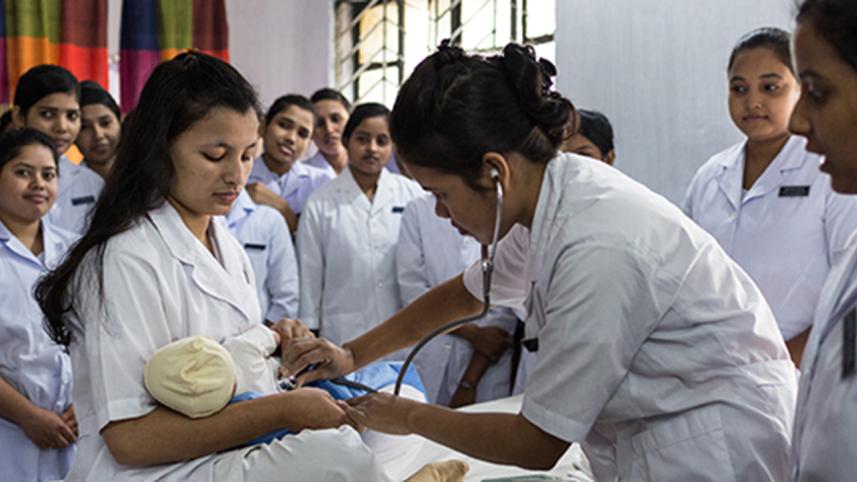More midwives needed to aid safe birth

Umme Kulsum was terrified when she encountered a mother in labour with no dilation around 3:00am at Brac centre in Dhaka. After several attempts, she could only bring out the baby's head. The mother was exhausted from all the pushing. But Kulsum trusted her midwifery skills and eventually conducted a normal delivery.
The baby was provided oxygen immediately afterwards to prevent neonatal death and other complications.
Currently, Kulsum, 39, a certified midwife, is serving the mothers and children of the Rohingya community at Ukhiya, Cox's Bazar.
"I am trained till the end to avoid C-section delivery as it causes health complexities in mothers and children. My midwifery training even taught me to repair 4-degree tears," said Kulsum.
Trained midwives can play a vital role in reducing the currently practised unnecessary C-section in Bangladesh. The latest data showed that the C-section rate has increased to eight folds in the past 14 years, believe public health experts.
According to UNFPA, global evidence shows that midwives educated and regulated as per the international standards can provide 87 percent of the critical care needed for women and babies, and investing in midwifery education and deployment to community-based services might potentially produce a 16-fold return on investment in lives saved and caesarian section expenditures avoided.
Unfortunately, trained midwives are often overlooked and their numbers are unproportionate, as data from Bangladesh Nursing and Midwifery Council (BNMC) showed that currently, there are about 7,122 registered midwives (Diploma in Midwifery 2012-2013), to look after an estimated 35 lakh pregnant women a year.
BNMC Registrar Rashida Akhter said, "We still have a scarcity of midwives. The number must increase, ensuring no union is left out. Furthermore, there must be community-based employment to reach mothers' doorsteps."
In January 2013, the Bangladesh government launched a separate cadre of professional midwives, a three-year Diploma in Midwifery.
James P Grant School of Public health, BRAC university, and UNFPA run a 3-year midwifery curriculum approved by BNMC.
Dr Sharmina Rahman, assistant director of Brac's Midwifery Education Programme, said, "To mitigate maternal mortality rate, midwives are essential and thus the profession is established globally. Earlier in Bangladesh, 3,000 midwifery posts were there, and 5,000 news posts will be created soon."
"Midwives assist mothers during the pre-labour and post-labour periods to ensure their sound health and that of their children. Hence, midwifery training should be developed in the private sector too," she added.
Another family welfare visitor (FWV), Fatema, 34, is pursuing midwifery training at Azimpur Maternity Hospital, Dhaka.
She has operated on several regular deliveries, even with the C-section history in the case of previous deliveries of the same mother.
After eighteen months of FWV training, followed by 6 months of basic midwifery training afterwards, these experts look after maternal and neonatal health all over Bangladesh.
Dr Md Mahmudur Rahman, director (MCH-services) and line director (MC-RAH) of DGFP, said, "Trained midwives look after mothers during their antenatal care to make the delivery time proper. Mothers die mostly from postpartum bleeding. These midwives understand this emergency. They also have the professional support and equipment with them."
Previously, Traditional Birth Attendants (TBA) performed normal deliveries at home, getting training under the Ministry of Health and Family Welfare (MoHFW). They assisted community women, especially in remote areas.
Sadly, TBA training has ceased in digital Bangladesh.
On the cancellation of TBA training, Dr Rahman said, "Major neonatal complications like Autism, Cerebral Palsy, and Down Syndrome are avertible within one minute of childbirth. Midwives identify those, whereas TBAs are not adequately prepared."
"Home deliveries must stop. Only 100 percent delivery in hospitals under expert midwives can ensure zero maternal deaths. Every union must need at least 3 midwives," he added.
However, Shireen Huq, a member at Naripokkho, said, "When there were no hospitals, TBAs worked as social workers, arranging safe childbirth. Their contribution should be recognised."
"Trained midwife tag brings class discrimination with financial issues. So, poor and underprivileged pregnant women face communication barriers," she added.
Bangladesh targets to make below 70 maternity deaths by the year 2030 to achieve the SDG target. Empowerment of more midwives can bring a huge development.




 For all latest news, follow The Daily Star's Google News channel.
For all latest news, follow The Daily Star's Google News channel.
Comments